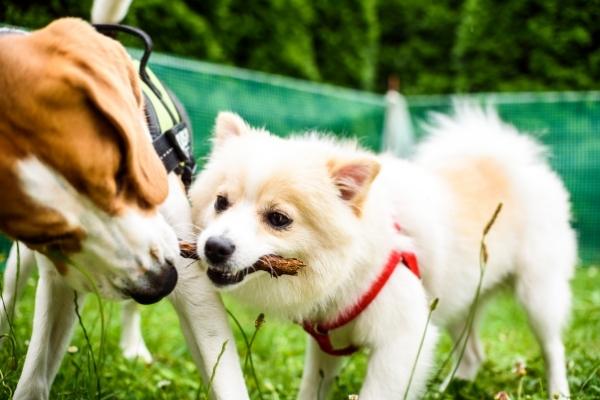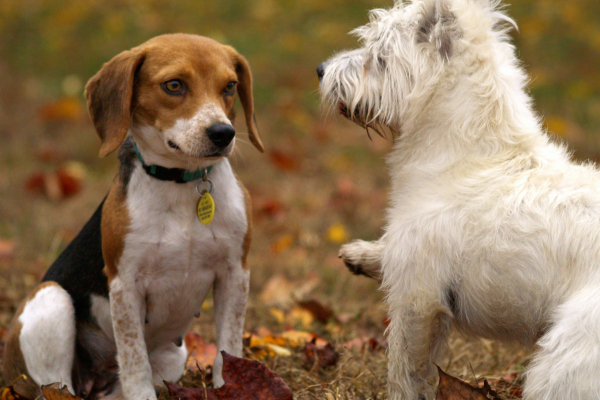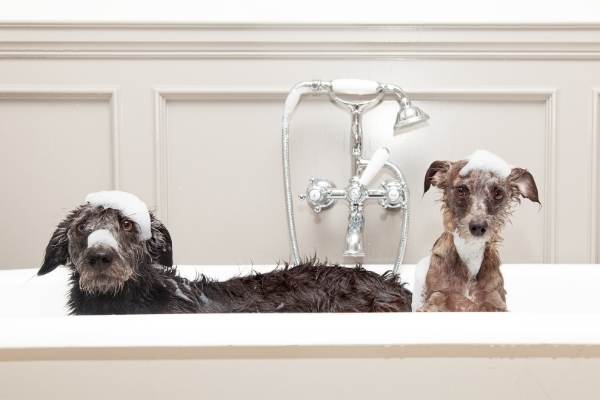Welcome to the final article in our 4-part series on pet adoption!
Part 1: Should I Adopt a Puppy or an Adult Dog?
Part 2: 4 Important Decisions to Make Before Adopting a Dog
Part 3: 15 Tips for Socializing Your Puppy
“Our dog needs a friend!”
Someone in your family is convinced a second dog would be the perfect companion for your current dog.

The thought stays with you as teasing, conflicting thoughts chase each other…
Aren’t you your dog’s “best friend?” He doesn’t need a companion. On the other hand, you can’t always spend as much time playing with your dog as you would like. Perhaps she’d like a puppy to nurture.
Your yard is large enough; two dogs could play together. Or, your yard barely supports the energy of one dog; two is out of the question.
You could take two dogs to the park as easily as one, but only if two carriers will fit in your vehicle.
The internal debate nearly drives you crazy, as family members plead for a puppy, or assert that a certain breed would be So. Much. Fun.
Before adding a second dog to your family, it’s good to look at as many factors as possible before making a commitment. To lessen the stress on everyone, follow these steps.

Step 1:
Consider your current dog’s temperament and prepare him for a new arrival
While some dogs may enjoy a playmate, other factors may make adding a second furry friend a negative experience, rather than a positive one. For example, if your current dog is shy, fearful, or anxious, he may not accept another animal in the household.
According to Kathy Santo, in a blog post for the American Kennel Club, “sometimes dogs can ‘pass’ their fear on to another dog, so then you could have two fearful dogs.”
A second dog will also not necessarily help socialize an aggressive dog.
Tip: Assess how well your dog interacts with other dogs in general. One way to do this is to take him to an off-leash dog park and observe how easily he makes friends.
Step 2:
Prepare yourself by thinking it through
Based on your current dog’s age, consider the ideal age for a second pet. Some people prefer their dogs to be similar ages, expecting the dogs to be playmates.
Dogs have different health needs at different stages of life, which is also a consideration. Depending on the age(s) of the dogs, expect to see behaviors in which an older dog is teaching a younger puppy social skills. Even if the dogs are the same age, one will have been with your family longer, and the other will be the “newcomer.”
Be aware of the financial aspect. Two dogs require more investment in food, supplies, and health care than one dog. Work with family members to plan and budget for a second dog.
Review information about dogs’ body language to better understand your dog’s reaction to the new arrival. Remember to verbally praise your current dog for good behavior, especially during the introduction period.
Tip: Create a simple chart listing the pros and cons of bringing a second dog into your household situation.
 Step 3:
Step 3:
Prepare your home before the new dog arrives
You’ll want to train a new dog to fit in with your family and lifestyle. Make sure you have supplies and areas ready to train your new pet in house manners and obedience. It may be easier to wait until your current dog is fully trained.
Tip: Consider your present situation in life. Are you willing and able to take the time and responsibility to train a second dog?
Step 4:
Prepare your family for a new pet
It also takes time to help a second dog acclimate and become part of your family. In the same way adding another person to a group of people changes the dynamic, the presence of another pet changes the dynamic of a household.
Tip: Make sure everyone in your family agrees with the idea. It’s especially important to realize the person who wants the dog may not take final responsibility for it. Consider creating a backup plan describing who will take responsibility if circumstances change.
Step 5:
Introduce your new dog gradually
Gradually introduce your dog to a “new puppy scent” by taking a piece of cloth when you meet your new dog before bringing her home. Allow your dog to smell any “new dog” scents from the cloth or your hands.
Set up a place for each dog to call its own (e.g., a pen or crate), and plan to use these areas in staggered rotation to help the dogs get used to each other. This may be done without the dogs seeing each other by strategically placing their private spaces and rotating which animal is with you or in their personal “safe” space. You may then wish to use a gate or screen to introduce the dogs face-to-face, allowing them to turn away after a brief meeting.
Respect and protect each dog’s needs. Arrange separate feeding areas to start, and allow each pet to have personal play time with you and other family members.
Tip: If possible, provide opportunities for each dog to become familiar with the other’s scent before or after bringing the new dog home.
 Step 6:
Step 6:
Continue the introduction process
Have someone help you introduce the dogs to each other “in person.” You might choose to take the dogs for a walk, each animal on a short, loose leash.
You can offer supervised play separately with each person, and then closer together as the dogs tolerate and accept each other.
Tip: Observe each dog’s behavioral clues, recalling the body language signals you reviewed earlier. Be ready to praise verbally and offer special attention to each dog at appropriate times.
The overall process will take time, so be patient. Be prepared to separate the dogs as needed, but keep working to gradually foster peaceful co-existence. If, over time, the relationship doesn’t improve, contact Atlantic Veterinary Hospital and ask about next steps you can take.
Remembering your pets’ temperaments and behavior signals will help you work with them for successful integration with your family.
Related Articles
- The Perfect Dog Breed for You, Based on Your Enneagram Personality Type
- 5 Steps to Introducing a New Kitten to Your Resident Cat
- 6 Brain Games to Keep Your Dog’s Mind Healthy
- 7 Ways to Care for Your Pet Without Breaking the Bank
- Why Dogs Chew Stuff, and How to Encourage Appropriate Chewing
- 10 Tips for Adopting a Cat


